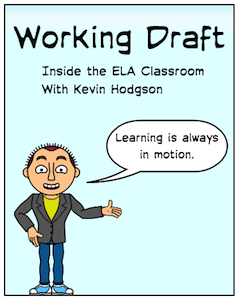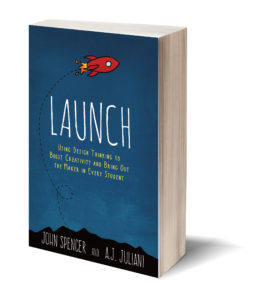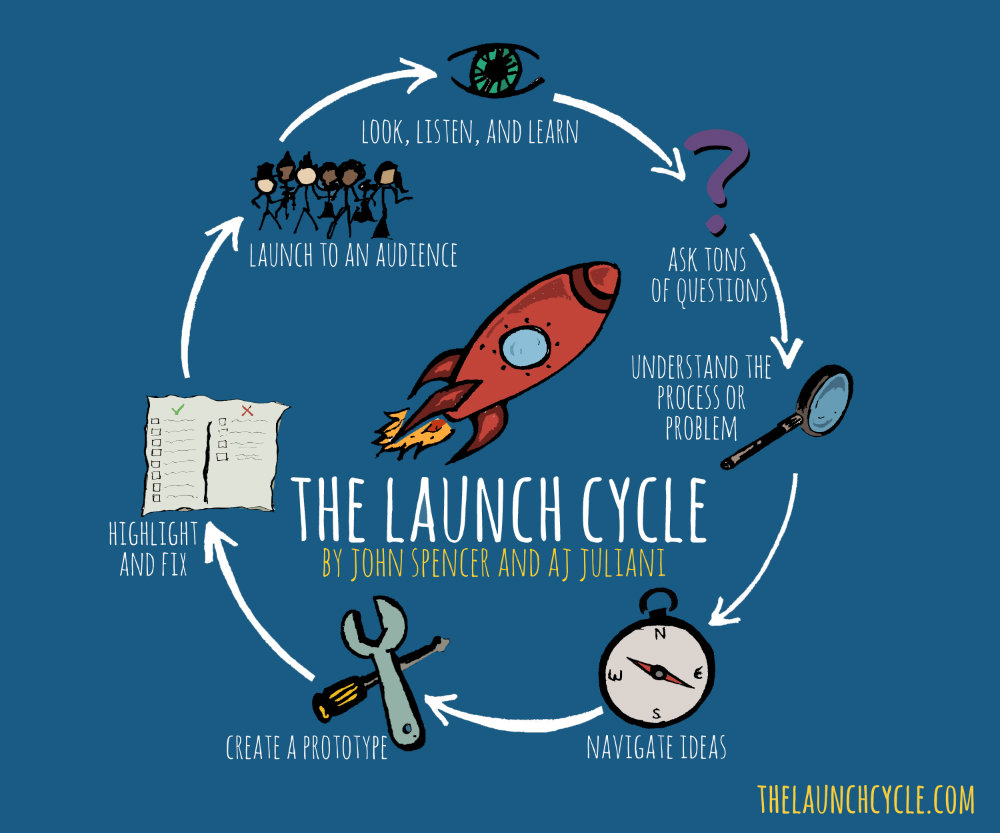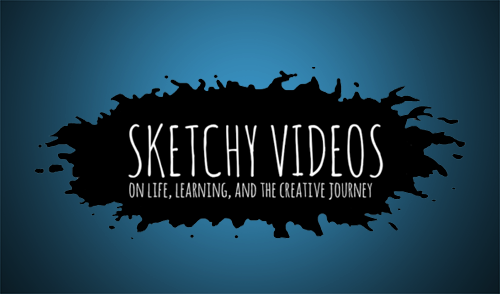Launching a New Design Process for Students
A MiddleWeb Blog

John’s blog site and free newsletter always have me thinking deeper on issues of importance. I seem to share out John’s musings quite often.
Take a look at his philosophy, which he has front and center at his website:
My goal is simple. I want to make something each day. Sometimes I make things. Sometimes I make a difference. On a good day, I get to do both. I believe all children are naturally creative. Using design thinking, teachers can transform classrooms into spaces of imagination and wonder.”

John Spencer
Along with another edu-thinker, A.J. Juliani, John Spencer recently released the book Launch as a way of putting his and Juliani’s ideas into action with pedagogy and examples from the classroom. LAUNCH, an acronym, refers to their re-interpretation of the design process.
I read Launch before our, well, launch of the Connected Learning MOOC (CLMOOC) in the summer, and the book’s core message around design and making and learning made a lot of sense in the context of what we were encouraging educators to be doing themselves.
I asked John and A.J. if I could pose some questions that stemmed from reading Launch and Spencer agreed. What follows is our conversation, done via Google Docs.
Kevin: You’ve taken elements of the traditional engineering design process and tweaked them into the LAUNCH acronym. Can you explain what LAUNCH means and how it connects to existing design principles?
John: The LAUNCH Cycle is a design thinking framework designed specifically for K-12 classrooms. It is based upon our own experiences using design thinking based upon the research, frameworks, and previous thinking models. Design thinking has a rich history in the arts, engineering, urban planning, and business. We spent years geeking out on these ideas before eventually coming up with LAUNCH.
This model differs from existing frameworks in a few respects. First, it treats the design process as “research and design.” We include an inquiry and media literacy piece before the ideation process. Also, it explicitly includes a launch phase that includes marketing and delivery. Whether students are designing a physical product, a digital product, or planning an event or a service, they think about what it means to have a product-market fit.
Kevin: Early in the book, you write about what you perceive as a “Creative Chasm” when it comes to a certain kind of learning in schools. You write that “ … students grow up immersed in a consumer culture and then attend schools where they consume rather than create knowledge (p.18).” Can you expand a bit on your concerns about this Creative Chasm and how your book aims to help teachers make a shift for their students?
John: For all the talk of “digital natives,” students are often “consumer natives” who live in a consumer society. I noticed this as a middle school teacher. Less than one percent of my students had created or edited anything multimedia. Less than a quarter of one percent had ever done coding. Only a handful had published anything online anywhere. They hadn’t used their devices for any kind of creative purposes.
I don’t blame them, either. We live in a capitalist, consumer-driven society. Even as we talk about the need for creativity, we see language around “jobs of the future.” We forget that the Creative Chasm is a human crisis. Kids miss out on something deeply human when they aren’t making.
Meanwhile, schools remain in an industrial model, where students passively consume content. Look at the language of school. We use phrases like “deliver instruction.” For all the talk of project-based learning and inquiry-driven learning, our schools often remain in this factory-style system. The last ten years have seen an explosion of policies that value test scores and accountability measures.

Kevin: I was intrigued by your designations of different creativity types (the artist, the geek, the architect, the engineer, the hacker, the point guard). I found myself thinking of last year’s students, and where they might fit in. I also wondered about where I fit in. Acknowledging that any category system leaves some people out, can you explain a bit why you worked to better understand different creativity types? How might those ideas be helpful to a classroom teacher?
John: We almost didn’t include that in the book, because of a fear that people might see creative types as being fixed. Looking back at this, it might have been better to think about these as creative mindsets or creative approaches. However, we included the chapter because we wanted teachers to see that there is no single “creative type.” Too often, people think about creativity as being artistic or working like an engineer. We wanted teachers to see the diversity in creative types and appreciate what they see in their colleagues and students.
Kevin: I was glad that you posed the question of how design thinking might be applicable across different content areas. With the Next Generation Science Standards, design thinking is a solid fit for most science units. But what about design thinking in English Language Arts? Or Math? Or Social Studies? Or Physical Education, Library or Art? Can you expand a bit on how your envision design thinking becoming part of the DNA of a school culture?
John: We both used design thinking in the humanities before ever using it in science. AJ was an English teacher and I was a social studies teacher. Over time, as I moved into self-contained (all subjects) I incorporated design thinking into math and science. We used in for hands-on projects, service projects, and publishing projects. This is why I’m convinced that it can work in all subjects.
Just the other day, I had a Skype with a librarian who has been using design thinking as a part of media literacy. The connections are all over the places. This makes sense. Learning doesn’t happen in isolated, discrete categories. It is, by nature, connective. It makes sense that design thinking would both connect to and transcend all subject areas.
Kevin: I appreciated the deep look at the importance of helping students develop probing questions that push learning and understanding with open-ended thinking. I know that, as a teacher, I need to do more work around the art of questioning. How does the role of questioning expand student thinking about the design process? What are some of the key strategies for encouraging questions that expand, as opposed to contract, inquiry?
John: Although we included questioning as an entire phase in the design cycle, we want to see students engage in constant questioning through the entire process. As they generate ideas, develop a plan, create a prototype, and engage in revision, they are constantly asking one another questions as well as engaging in self-reflection. It’s a vital part of the entire process.
“Are all questions allowed? Are students assured that there are no stupid questions? Is the teacher modeling active curiosity?”
For some students, it helps to see examples and sentence frames. They aren’t used to asking a ton of questions and they need some scaffolding. However, many students simply need the permission and the right classroom culture. Are all questions allowed? Are students assured that there are no stupid questions? Is the teacher modeling active curiosity?
Kevin: You spend a lot of time connecting design to research, and expanding the definitions of what research should be in classrooms. One of your headers even states, “We need a bigger definition of research.” Given that the student research component is now embedded strongly in Common Core and in related curriculum maps, can you explain some ways that we can engage students in research that is thoughtful and interesting?
John: We’ve made research way too complicated. Students tend to do online or book research using a rigid process. It’s a bit like what’s happened with close reading. Teachers can break past this by integrating research into regular lessons in a way that feels natural to students. When they write blog posts, let them go online and research without having to fill out a worksheet or “prove” that they are doing the research. When they are doing a debate, let them Skype with an expert. When they are planning out their science experiments, let them look at videos and ask tons of questions. It doesn’t have to be a design project. It’s something they should be able to engage in all the time.
Kevin: I think all teachers struggle with making the revision process meaningful to students, who often want to be done when they are done. You work this revision into the LAUNCH design process with the “highlight and improve” elements. Can you talk a bit about how important that step is and how you create a classroom culture for such work? Is there a way to connect that revision process with revision in other content areas?
John: Revision is vital for design. You see this with Pixar. Their movies start out as awful and, through experimentation, they grow into something amazing. I recently listened to Malcolm Gladwell’s podcast on the song “Hallelujah.” That song was a disaster at first, but through iterations it became epic.
“Teachers should have their own Genius Hours … there is value in being creative (especially in a new realm) around students.”
This is a critical lesson for kids to internalize. Creative work is often slow. It includes mistakes. Tons of them. However, as they work through this iterative thinking, their work improves and they engage in constant problem-solving. They grow less risk-averse and build up creative endurance. So, it becomes this incredibly valuable part of being a creative person.
Unfortunately, schools are slow to embrace revision as a part of the process. Traditional grading says, “you better get it right the first time, because we’re averaging your grades.” Curriculum maps and lesson plans move learning through a frantic pace and students don’t get the time to have the slack they need to embrace revision. As teachers, we can help them embrace revision by using standards-based grading, encouraging creative risk-taking, and giving students tons of time to revise.
Kevin: So much of our teacher professional development seems to fall into all of the “worst practice” that we try to avoid in our classrooms. We sit and are talked to by “professionals.” We are shown in slideshows something new. We are expected to absorb, not do. (Or, do it later, on our own.) So I appreciated your comment that “…teachers should have their own Genius Hours … there is value in being creative (especially in a new realm) around students.” How do we encourage administrators to make a shift in professional development to empower teachers in this way? How do we encourage teachers to make this leap and learn alongside with students?
John: This is a hard risk for administrators, because a Genius Hour could easily become an “I’m just going to grade papers” hour or “I’m just going to binge-watch Netflix” hour. However, when an administrator provides a Genius Hour, he or she is making a bold statement about trusting teachers to own their own learning.
“When an administrator provides a Genius Hour, he or she is making a bold statement about trusting teachers to own their own learning.”
Unfortunately, most administrators won’t provide a Genius Hour for teachers. Some of this might be tied to policies. The district often has tight policies on what counts for professional development. In these moments, we just have to carve our own Genius Hours as educators and then model the learning, making, and creative thinking for students.
Kevin: What’s the last thing you designed?
John: I carve out time each day for creative work. Sometimes it’s a few hours. Other times, it’s a full day. I always have several projects going on at the same time – and each one uses design thinking. Right now, I’m working on a coding project and I’m about to do some Raspberry Pi projects with my kids. I also put the finishing touches on another sketchy video just this morning. This last week, I finished designing an educational technology course, and, when I hit creative blocks in that, I often shifted back into working on Taco Tony, a graphic novel for my kids about a superhero taco.
In each case, I am working through elements of the design thinking process. But it looks different with each project. In the case of the sketchy video, there is less inquiry and research, but there is definitely ideation, creation, revision, and a launch. I started with awareness and empathy toward my audience. However, in the case of designing a course, it has been longer and slower, with more time spent in research, data analysis, and ideation and less time spent in creating the course.






































What a neat way to envision design thinking! I like the informal, understandable language in the cycle. It would not intimidate kids. (Or teachers). I intend to read the book. Thanks for your terrific approach to education, Kevin.
Thanks. Just to be clear: The book is written by John Spencer and AJ Juliani, not myself (I wish!). I was just reviewing and asking questions about the concepts in the book.
Kevin
Thanks Kevin. This article and the LAUNCH process describe the type of learning I’ve been championing in my blogs and conversations with you and #clmooc for a long time. We need to learn these habits as we grow up and learn to apply them to creating solutions to real world problems. Here’s a recent blog article where I include graphics and links to other articles that describe a “making a better world” process. I plan to borrow your graphic and add it to this collection.